2001 Research Experiences for Undergraduates Program
 National Radio Astronomy Observatory
National Radio Astronomy Observatory
2001 is the 42nd Anniversary of the NRAO Summer Student Program!
Research Projects by NRAO Site

There are five students in the 2001 Summer Student Research Program,
four of them under the NSF Research Experience for Undergraduates (REU)
program at NRAO-Charlottesville. Highlights of the program included a series
of introductory level lectures on aspects of astronomy, particularly radio
astronomy, spread over a few weeks. These lectures are intended to aquaint
the students with the research which various staff members carry out. The
lectures are listed below.
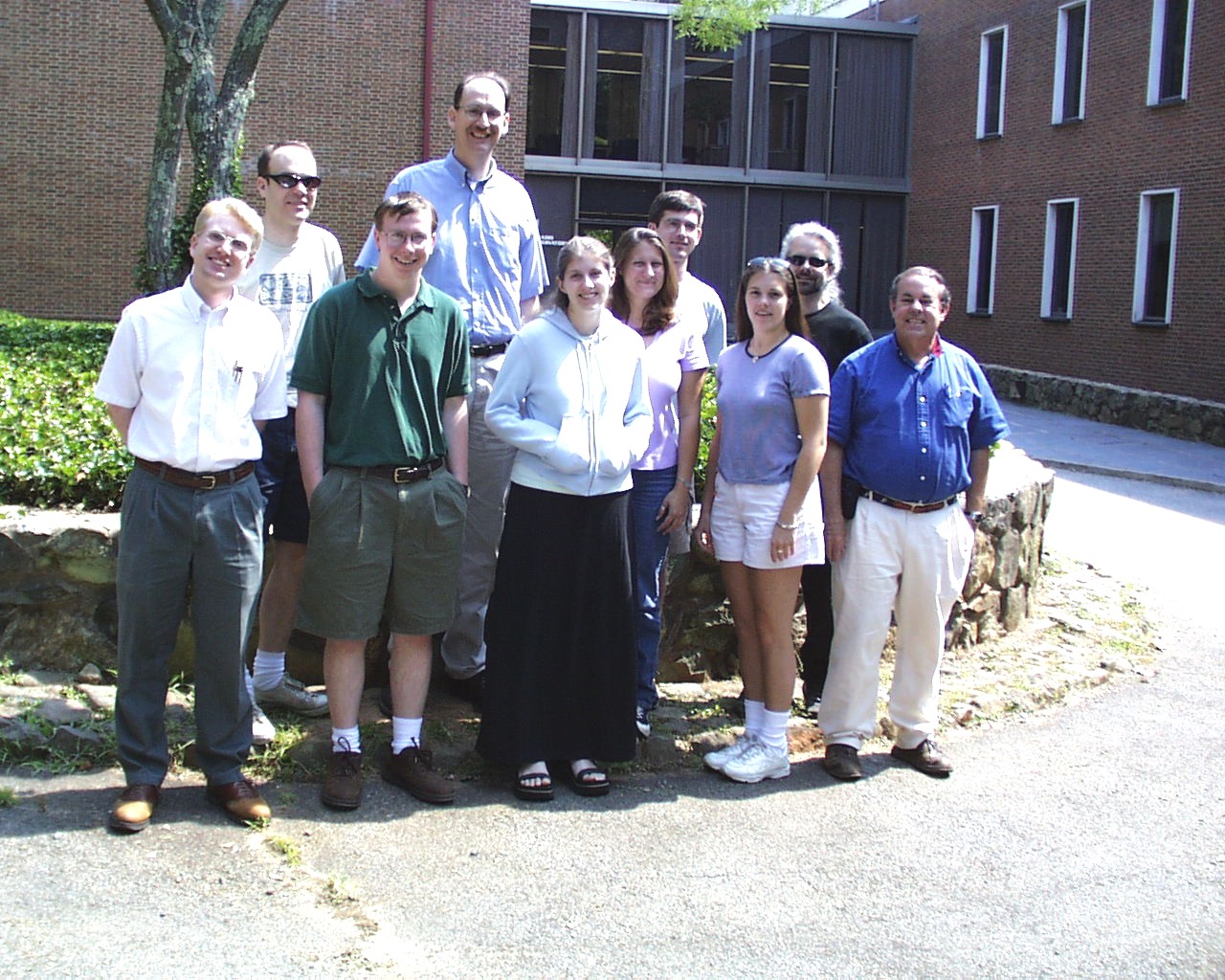
2001 Summer students from Green Bank traveled to Charlottesville to
tour the CDL, U. Va. and NRAO HQ. (l-r) Paul Robinson, Matt Lister, Michael
Wallace, Richard Simon, Emily Freeland, Julie Rupert, Zach Manganello,
Melissa Williams, John Hibbard and Al Wootten.
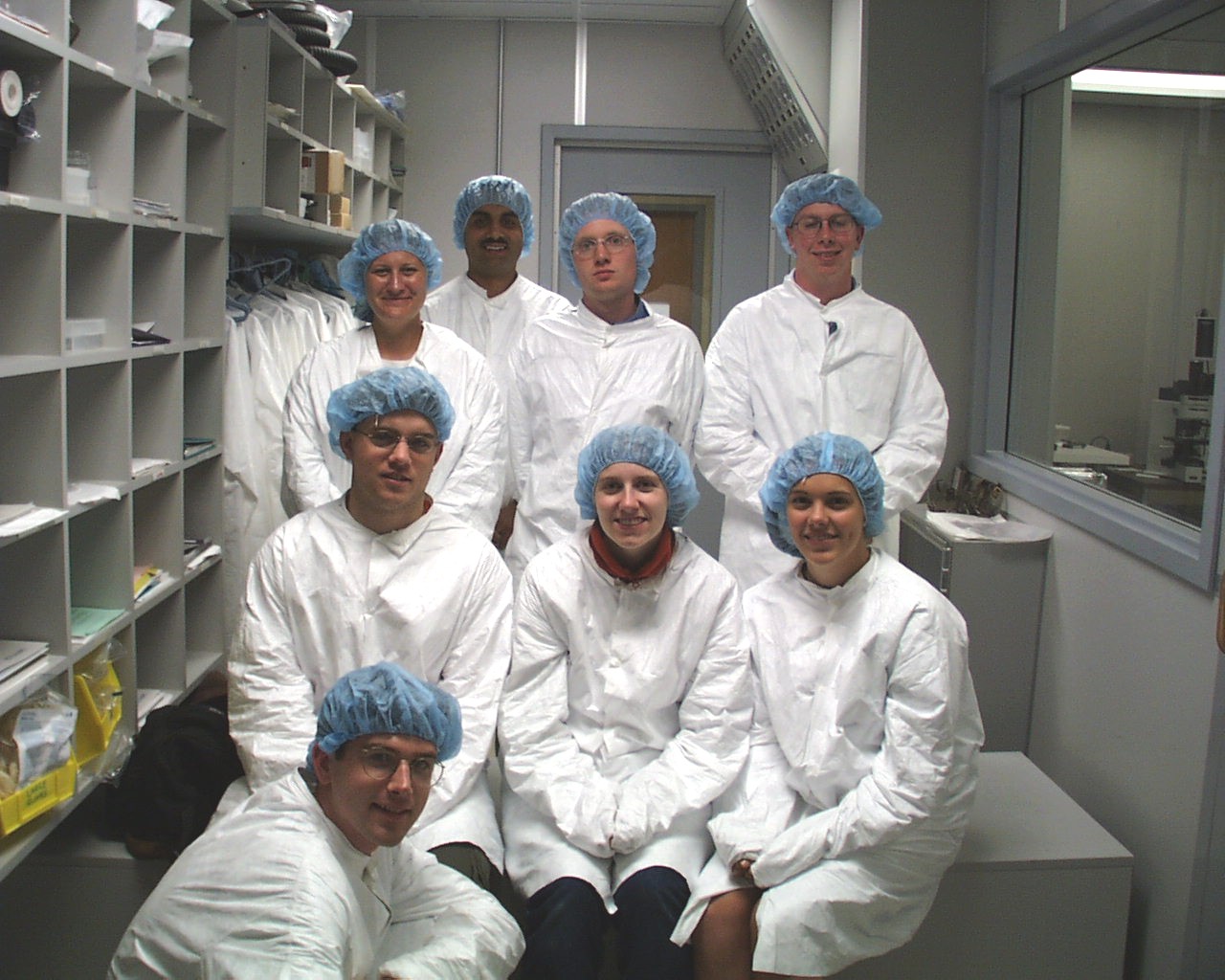
Many of the students in the NRAO-Green Bank program visit Charlottesville
for a tour of the Central
Development Laboratory , and of the University of Virginia's facility
for the fabrication of the Semiconductor-Insulator-Semiconductor detectors
used in millimeter wave receivers, the Applied
Electrophysics Laboratory.
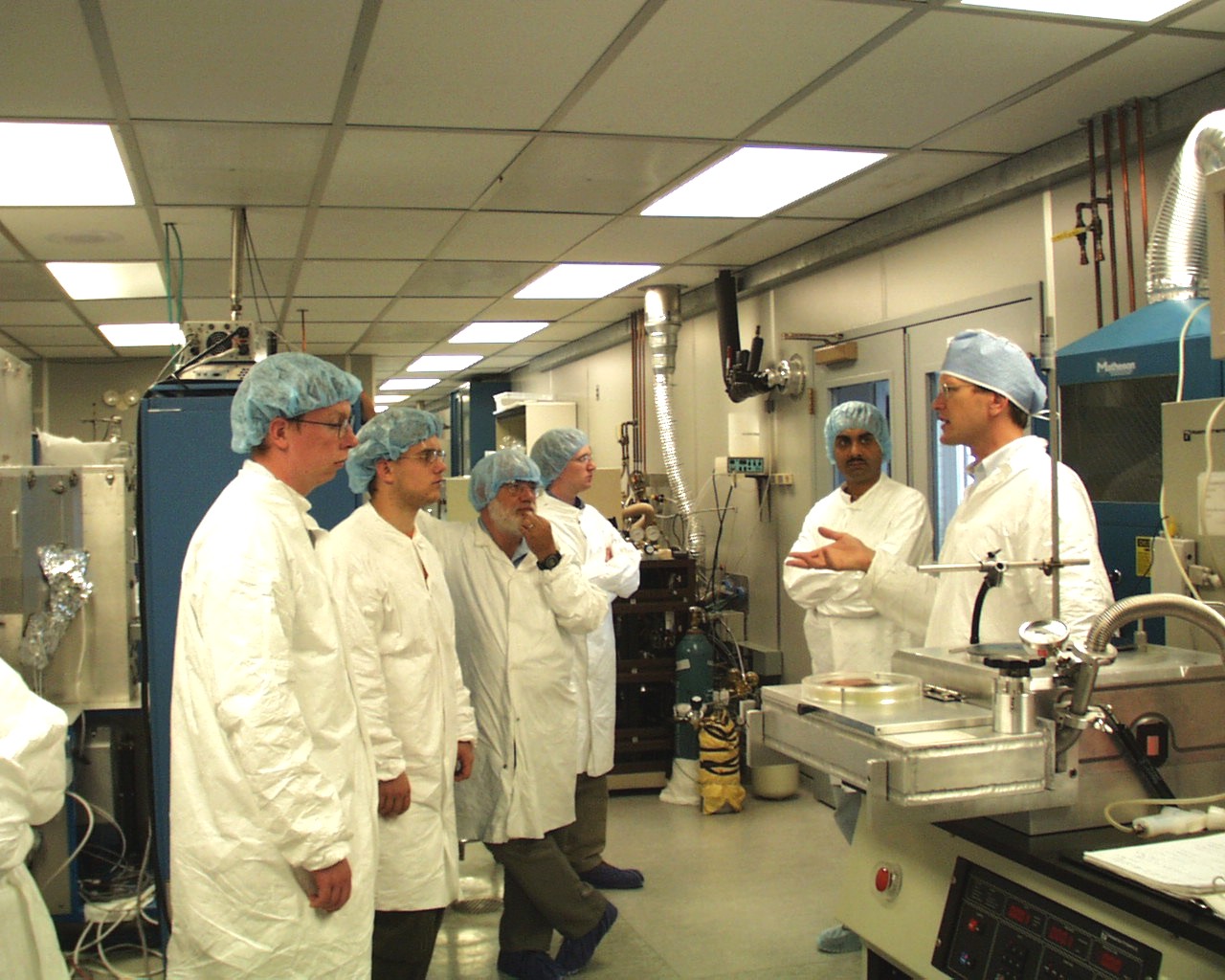
Students in the Clean Room where SIS mixers are made. (l-r) Michael
Wallace, Tim Thacker (second generation NRAO summer student), Skip
Thacker (NRAO Summer Student 196?), Paul Robinson, K. Saini and A.
Lichtenberger.
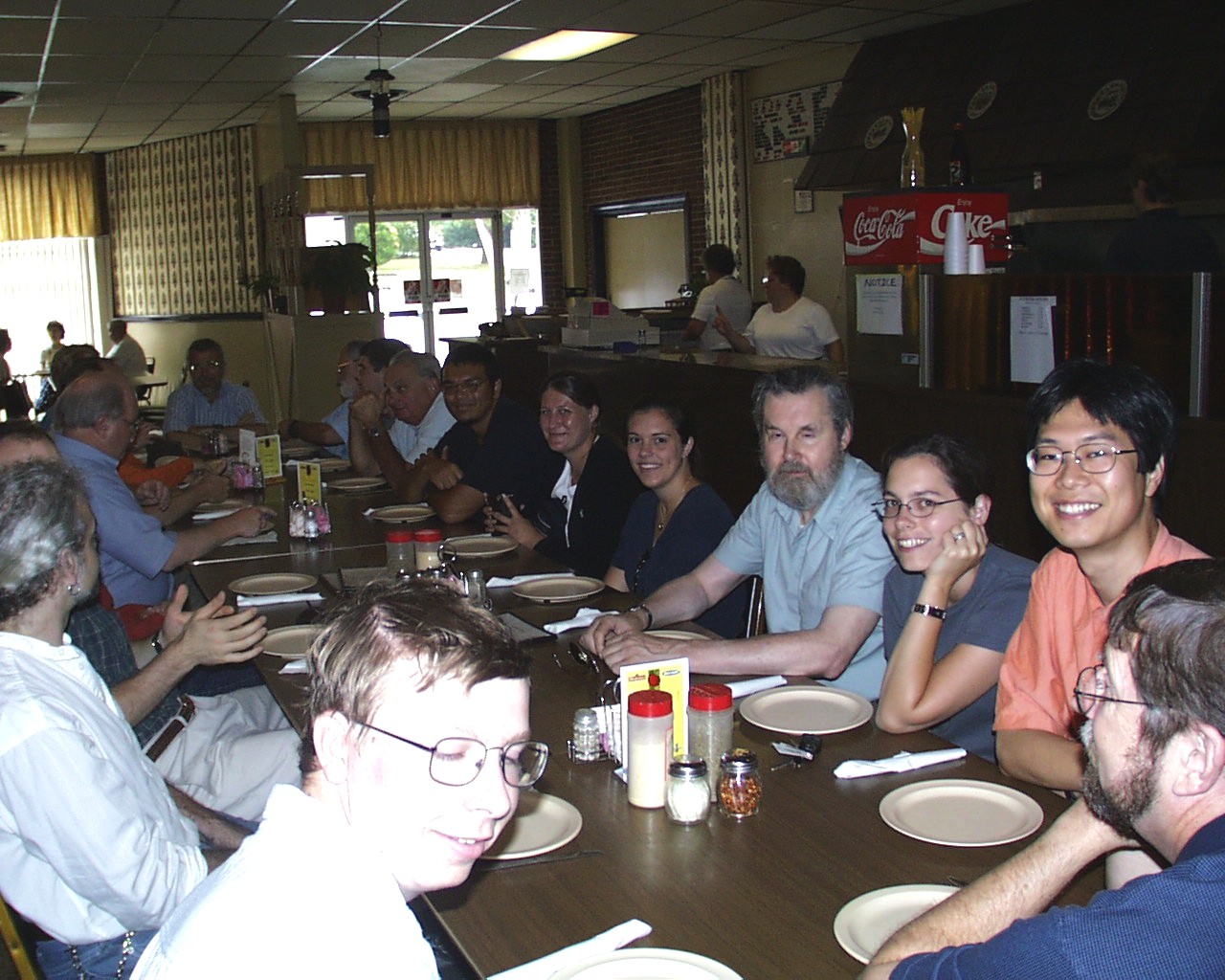
2001 Summer students from Green Bank and Charlottesville met at a pizza
lunch get-together with mentors and lecturers and U. Va. personnel in Charlottesville.
The 2001 students enjoy an informal get-together with astronomers from
the University of Virginia and NRAO at lunch. followed by a visit with
graduate students from the University's
Astronomy Department.
Later in the summer, the Charlottesville students visited Green Bank
again to tour the NRAO telescopes located there, to meet members of the
Green Bank staff, and to attend the annual picnic on 28 July.
One highlight will be initial operations of the Green Bank telescope
( GBT ), the world's
largest steerable telescope. It is an offset parabaloid, 110m across the
longest axis, incorporating 16 million lbs of steel in the moving structure.
The 40 ft telescope there is a student telescope, open for any project
which students would like to carry out on it (though its instrumentation
is limited). If there is interest, we may carry out, probably remotely,
a project on the VLA.
We're very excited about the Atacama
Large Millimeter Array, which was selected as the top priority for
a new astronomical instrument in the 90s back at the beginning of the decade
by the Astronomy Survey Committee. Students got to see it take shape as
the fourth year of design and development gets underway.
The students give a series of 15 minute talks on their projects during
a lunch symposium in Charlottesville before they begin leaving for the
summer. They produce short reports describing their summer research.
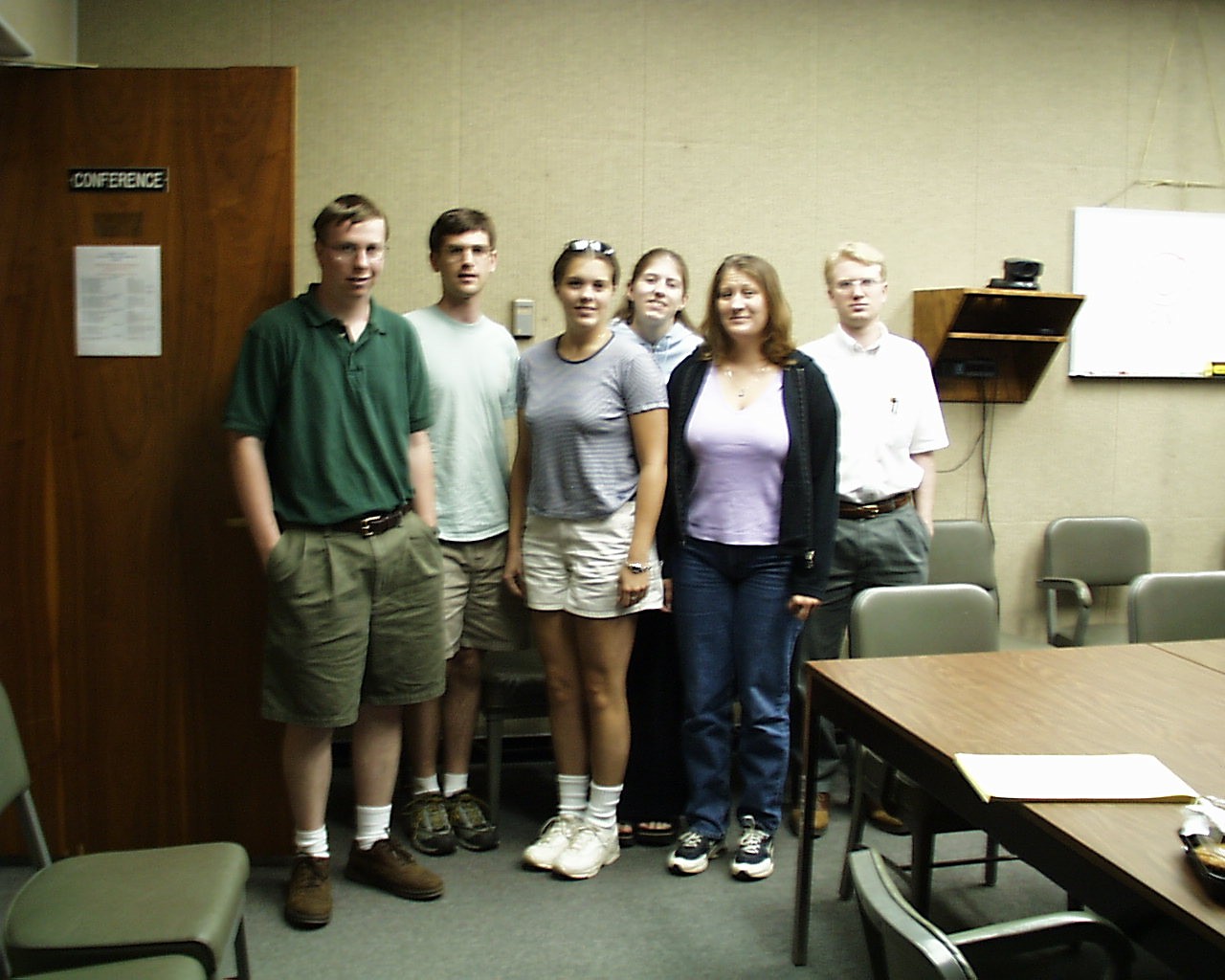
Students (l-r) Michael Wallace, Zach Manganello, Melissa Williams, Emily
Freeman, Julie Rupert and Paul Robinson leave full of cosmology after a
lecture by Juan Uson.
CV Summer Student Schedule, Summer 2001
| Date |
Person |
Item |
Location |
Time |
| 18 May |
open |
Students begin arriving |
|
|
| 4 Jun |
open |
All students have arrived |
at the Observatory |
9pm |
| 14 June |
Murphy |
Introduction to Radio Astronomy |
NRAO,Room 317, Stone Hall |
9am |
| 15 Jun |
open |
Public Night at McCormick Observatory |
at the Observatory. By the end of public night,
Mars should be above the trees, and will be about 19-20" in diameter. Should
be an impressive sight, even through a small telescope. |
9pm |
| 18 June |
Wootten |
The REU Program at NRAO; From millivolts to Column
Density |
NRAO,Room 317, Stone Hall |
9am |
| 20 June |
Turner |
Interstellar Molecules |
NRAO,Room 317, Stone Hall |
9am |
| 22 June |
Condon |
Radio Sources |
NRAO,Room 317, Stone Hall |
9am |
| 25 June |
Lister |
TBA |
NRAO,Room 317, Stone Hall |
9am |
| 27 June |
Open |
TBA |
NRAO,Room 317, Stone Hall |
9am |
| 29 June |
Kempner |
Radio Relics and Halos |
NRAO,Room 317, Stone Hall |
not given |
| 30 June |
Goldin |
MAP Satellite Launch |
Cape Canaveral |
?? |
| 30 June |
Open |
Comet
LINEAR (C/2001 A2) swings by Earth |
Dark skies near you |
Look Up! |
| 2 Jul |
Open |
|
NRAO,Room 317, Stone Hall |
9am |
| 4 July |
Fireworks! |
|
McIntire Park |
Dark |
| 6 July |
Kellerman |
The Development of Radio Astronomy |
NRAO,Room 317, Stone Hall |
Ppnd |
| 6 Jul |
open |
Public Night at McCormick Observatory |
at the Observatory |
9pm |
| 9 July |
Hogg |
Radio Stars |
NRAO,Room 317, Stone Hall |
9am |
| 11 Jul |
Liszt |
The Galactic Center |
NRAO,Room 317, Stone Hall |
9am |
| 13 July |
Sarazin |
Chandra: X-ray Astronomy |
NRAO,Room 317, Stone Hall |
9am |
| 16 Jul |
Wootten |
ALMA and Star Formation |
NRAO,Room 317, Stone Hall |
9am |
| 18 Jul |
Wootten |
ALMA and Star Formation (continued) |
NRAO,Room 317, Stone Hall |
9am |
| 18 Jul |
Wootten |
Visit of Green Bank Students to Charlottesville |
NRAO,Room 317, Stone Hall |
pm |
| 19 Jul |
Bradley |
Central Development Lab Introduction |
Rm 228 Ivy Road |
9am |
| 19 Jul |
Thacker |
Tour of Central Development Lab |
Rm 228 Ivy Road |
10am |
| 19 Jul |
All |
Pizza Lunch with U. Va. |
Anna's Pizza |
12pm |
| 19 Jul |
Crowe |
Tour of U. Va. Device Fabrication Facility |
U. Virginia |
1:20pm |
| 19 Jul |
Wootten |
BBQ for CV, GB REUs and mentors |
Edgemont Road Garden |
6pm |
| 20 July |
Uson |
Cosmology |
NRAO,Room 317, Stone Hall |
9am |
| 20 July |
open |
Public Night at McCormick Observatory |
at the Observatory |
9pm |
| 23 July |
Hibbard |
Galaxy Morphology |
NRAO,Room 317, Stone Hall |
11am |
| 25 July |
Hibbard |
Interacting Galaxies |
NRAO,Room 317, Stone Hall |
1pm |
| 27 July |
Kempner |
Radio Relics and Halos |
NRAO,Room 317, Stone Hall |
9am |
| 27 July |
All |
CV REUs -> Green Bank Picnic |
Green Bank, W. Va. |
evening |
| 28 July |
All |
CV REUs -> Green Bank Picnic |
Green Bank, W. Va. |
noon |
| 29 July |
All |
CV REUs tour GB; return from Green Bank Picnic |
Green Bank, W. Va. |
noon |
| 30 July |
Open |
Open |
NRAO,Room 317, Stone Hall |
9am |
| 31 July |
Students |
REU research presentations |
Rm 317, Stone Hall |
high noon |
| 1 August |
Open |
Open |
NRAO,Room 317, Stone Hall |
9am |
| 3 Aug |
open |
Public Night at McCormick Observatory |
at the Observatory |
9pm |
| 11 August Aug |
Leonids |
Meteor Shower |
Deltaville, Virginia |
Midnight |


Circular Polarization Imaging of Active Galactic Nuclei at 43 GHz
This observational study involves a search for circularly polarized emission
in a sample of bright, flat-spectrum AGNs at 43 GHz. The data were taken
with the VLBA over the period 1999-2000 and include many well-known blazars
such as 3C 273 and 3C 279, both of which have been found to display circular
polarization (C.P.) at lower frequencies. Since the data were originally
processed with only linear polarization images in mind, this project will
involve a careful re-calibration of the data, paying close attention to
the relative calibration of the left and right complex antenna gains.
Models of intrinsic circular polarization predict a higher amount of
C.P. at 43 GHz than at lower frequencies due to reduced opacity and other
effects. These data can therefore provide a useful means of distinguishing
between competing intrinsic C.P. and Faraday conversion mechanisms in AGNs.
Using the multiple epochs available for 3C 279, it will be possible to
check for variations of C.P. in this source at 43 GHz. Homan et al.
(1999) found 3C 279's C.P. to be highly stable at 15 GHz, which is unusual
given its large variations in linear polarization and intensity. This project
is best suited for an advanced undergraduate student or graduating senior
who is interested in learning about AGNs and cutting-edge VLBI research.
The work is likely to be data-intensive, with a smaller amount of time
spent on theory.


Megan Kohring, of The University of Virginia
will work with John Hibbard
in collaboration with J. Barnes (IfA) on
Tidal Dwarf Formation in Tidal Tails
It has long been known (eg Schweizer 1978) that clumps of star formation
with properties similar to dwarf galaxies exist within tidal features.
Some of these features show enhancements also in the underlying stellar
light and in the neutral gas column density and line-profile width,
leading to the suggesting that they will evolve into independent dwarf
galaxy satellites. This suggestion is supported by detailed numerical simulations
which demonstrate that self-gravitating structures can indeed develop in
tidal material torn off during galaxy interactions. However, the
observational evidence that optical enhancements within the tidal tails
are in fact distinct identities is rare or non-existence. Many may be simply
unbound collections of young stars recently born within the tail, but destined
to fade into obscurity within a few hundred million years.
The goal of the present project is to identify bound clumps within tidal
tails generated via numerical simulations of merging galaxies, and to quantify
their expected observatial characteristics. Simulated maps of the integrated
intensity, velocity field, and velocity dispersion will be generated and
examined to see if the location of the bound clumps distinguish themselves
from projected (but unbound) enhancements. Next, the student will make
simulated measurements of the dynamical mass of the clumps (from the half-light
profiles and "observed" velocity dispersion), and compare these values
to their "true" mass. Finally, the student will examine high-resolution
HI observations of the nearest and most famous tailed merger, NGC 4038/9
("The Antennae") to see if any of the regions within its tails exhibit
the expected behavior of bound clumps.
A report on this research may be read.

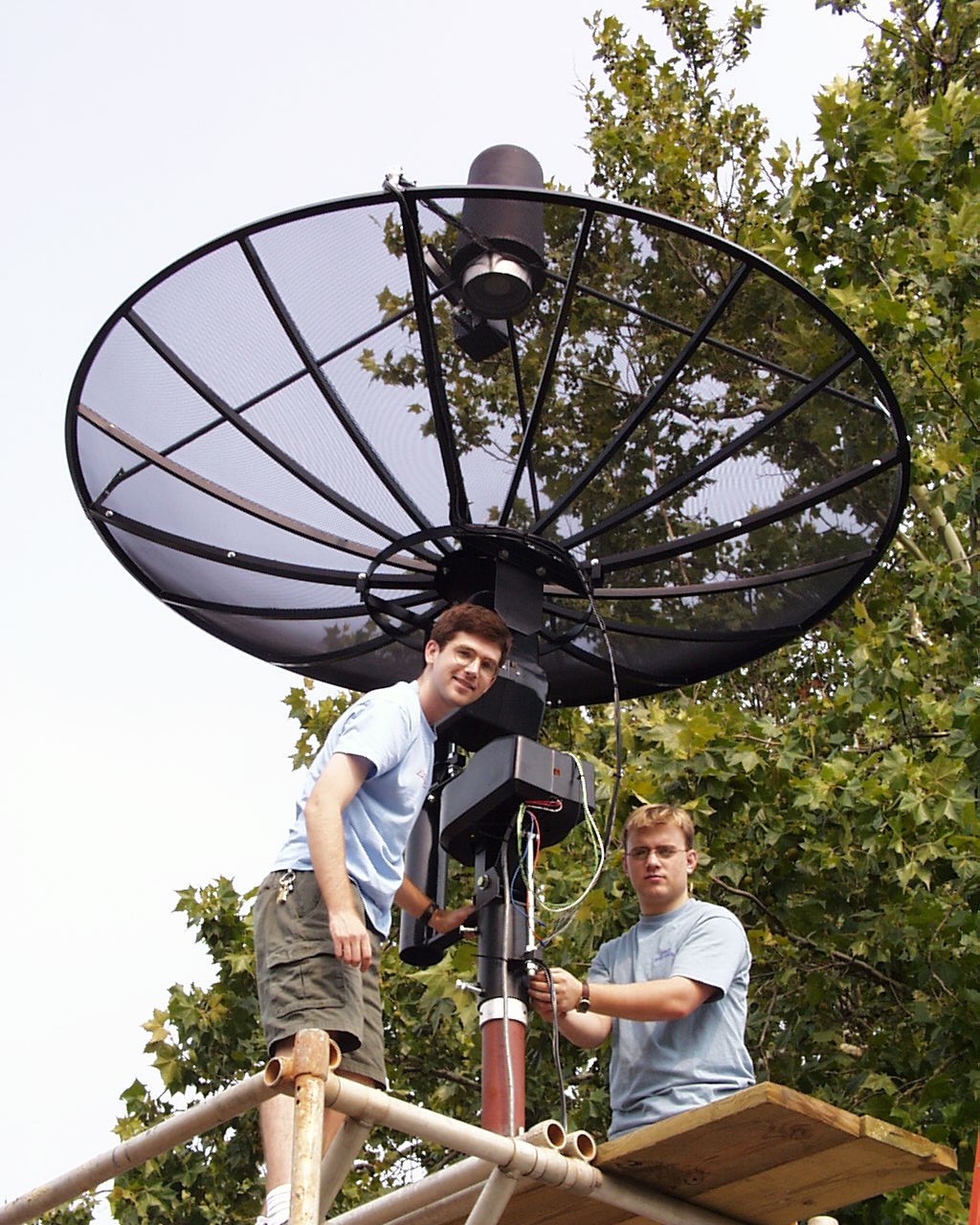
2001 Summer students Zach Manganello and Tim Thacker mount the Charlottesville
Telescope (CVT) between NRAO and U. Va. Astronomy.

Zachary Manganello , of Middlebury College 
works with Lynn Matthews and John Effland
on
The Small Radio Telescope
A version of the Haystack Small Radio Telescope kit will be constructed.


Juliette Rupert , of The
University of Oklahoma 
works with Richard Simon
on
Identifying Promising Target Stars for the Terrestrial Planet Finder Mission
There is widespread interest in the problem of identifying and characterizing
Earth-like planets that might exist around nearby stars. To date, little
systematic work has been done on carefully identifying the few hundred
nearby stars that are the most promising candidates for a search of this
type. By using a combination of careful calculation and detailed work with
the literature, it should be possible to create a definitive list of the
most promising stars for such searches. This work will have a significant
effect on the planning of future space missions and will also prove useful
to a number of monitoring programs already underway.


SIS Mixer Test System
Following our specifications and under the guidance of CDL engineering,
the student would design circuits and construct hardware for the SIS mixer
test system. This hardware would consist of measurement subsystems
such as control of LO frequency and power, amplifier bias supplies, or
mixer bias supplies. The student would be required to design analog
circuits consisting primarily of op amps and would create mechanical designs
using AutoCAD. The student would be expected to write software for
automated testing of the hardware. CDL engineering would provide
to the student the software design consisting of UML class, sequence, and
activity diagrams. The student would be expected to write and document
object oriented code that meets the software design requirements.

NRAO/Socorro 2001 Research Experience for
Undergraduates (REU) Program
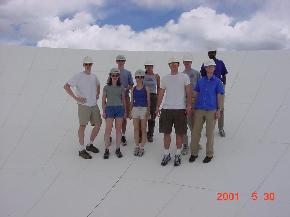
2001 Summer students from Socorro in a VLA antenna (photo courtesy of
J. Anderson).

The summer REU program at NRAO/Socorro in 2000 consists of 4 main categories
of activity:
1 - student research projects, in collaboration
with an NRAO advisor
2 - lectures to the students by NRAO staff members
3 - a joint student project, involving observations
with the Very Large
Array (VLA)
4 - guided tours of the VLA, given by the students on weekends
The 2001 REU program at NRAO/Socorro is under the direction of Tracy
Clarke
and Greg Taylor. Dr. Clarke is
Jansky
Postdoctoral Researcher at NRAO/Socorro, and Dr. Taylor is a member
of the scientific research staff.

Lectures, etc...
Several lectures about radio astronomy and interferometry will be presented,
allowing the students to obtain a good understanding of the technique.
Talks were also given on general topics in astronomy, presented by members
of the scientific staff. The astronomy talks were designed to give the
students an understanding of what sort of research goes on at NRAO, and
in radio astronomy in general. The detailed list of lectures and events
for the summer is in the following table and at the
AOC
WWW site
.
Preliminary 2001 Summer
Student Calendar of Events
May 2001
May 18: Colloquium by Steve Myers, "Latest Results
from the Cosmic Background Imager"
May 25: Colloquium by David Wilner, "Dusty Disks
around Young Stars"
May 30: 10:00 am. VLA Tour #1 by Dave Finley
& Vivek Dhawan
May 31: 9:00 am. Safety Lecture #1 by Jon Spargo,
3'rd floor conference room
May 31: 4:00 pm. "What is Radio Astronomy?" by Jim Ulvestad
June 2001
June 1: Colloquium by Lincoln Greenhill, "A Pirate's
Treasure Map of Orion BN/KL - X Marks the Spot, but is it a Trick?"
June 5: 11:00 am. "Fundamentals of Radio Astronomy" by Rick Perley
June 7: 4:00 pm. "Imaging and Deconvolution" by Tim Cornwell
June 12: 11:00 am. "Basics of Spectral Line" by Claire Chandler
June 14: 10:00 am. VLA Tour #2 by Dave Finley
& Vivek Dhawan
June 15: Colloquium by Mark Gurwell, " Millimeterwave
Astronomy of Planetary Atmospheres"
June 19: 11:00 am. "Polarimetry" by Greg Taylor
June 19: 3:00 pm. Safety Lecture #2 by Jon Spargo,
auditorium
June 20-22: KPNO/Tucson tour
June 22: Colloquium by David Hughes
June 25: VLA observing run
June 26: 11:00 am. "Radio Evidence for Black Holes in Nearby Galactic
Nuclei" by Joan Wrobel
June 28: 4:00 pm. "VLBI" by Craig Walker
June 29: Colloquium by Geoff Marcy
July 2001
July 3: VLA observing run
July 3: 3:00 pm. TBA by Henrique Schmitt
July 4: Holiday
July 5: 4:00 pm. TBA by Dale Frail
July 10: 11:00 am. "Molecular Clouds and Star Formation" by Debra
Shepherd
July 12: 4:00 pm. "Atronomical Masers" by Mark Claussen
July 17: 11:00 am. "Magnetic Fields in the Universe" by Crystal
Brogan
July 19: 4:00 pm. "Cosmic Microwave Background" by Steve Myers
July 24: 11:00 am. Colloquium by Swarup
July 25: 12 pm Summer student talk by Aaron
Boley
July 28: TRIP TO APACHE POINT
July 31: 11:00 am. "Planetary Radio Astronomy" by Bryan Butler
August 2001
Aug 1: 12 pm. Summer student talks by Daniel S.,
Marj, Jason, and Jenn
Aug 2: 4:00 pm. "Microquasars" by Vivek Dhawan
Aug 7: 12 pm. Summer student talks by Diane,
Mike, Matt, and Cristina
Aug 7: 4:00 pm. "Properties of HI in Nearby Galaxies" by Dave Thilker
Aug 8: 12 pm. Summer student talk by Bhasker
Aug 15: 12 pm. Summer student talks by Jim,
Katie, Daniel P., and Stacy

Joint Student Research Project
The VLA is in its CnB and C configurations this summer. Some telescope
time will be allocated to the summer students to pursue group projects.
Note that last summer one of the NRAO student projects resulted in an
exciting discovery of the first radio emission detected from a brown dwarf
star! This discovery resulted in a paper in Nature. More details are available
on the NRAO press
release web page.

Planned Trips
Kitt Peak/Tucson
- June 20-22
Apache Point - July 28
Other Stuff
A Basic Information Letter is available from the WWW pages.

Student Research Projects
Each of the REU students will work with one or more advisors on one
or more projects throughout the summer. This is the main focus of the program,
and the majority of the students' time will be spent on these research
endeavors. These projects involved observing, data reduction and analysis,
equipment development, and theoretical studies. At the end of the program,
each student gave a lunch talk explaining the main project(s) he or she
worked on during the summer. The possibility exists for the students to
present their original research at scientific meetings deemed appropriate
by their advisor(s). Following is a detailed list of the specific projects
carried out by the NRAO/Socorro REU students:

works with Steve Myers
on
The CLASS Survey
In the next couple of months, a copy of the full CLASS archive (now only
at Jodrell Bank) will be set up here at NRAO. There will be the opportunity
to then develop some summer student projects based on the CLASS archive.
For example:
- morphological classifications
- polarization properties
- correlations with other surveys (eg. FIRST)
- update of astrometric catalogues (CLASS accuracy is ~15-30 mas)

James Anderson of New Mexico Tech
works with Jim Ulvestad
on
The Flare in NGC 7582--AGN or Supernova?
The Seyfert galaxy NGC 7582 turned from a Seyfert 2 to a Seyfert 1 galaxy
in mid-1998; broad permitted emission lines appeared at the same time that
an X-ray flare occurred. The optical spectrum during the flare was similar
to that of a Type IIn supernova, so it has been suggested that the flare
was due to a supernova rather than an AGN associated with a massive black
hole. Many Type IIn supernovae are detected as radio sources, peaking at
500-1000 days after their optical flares. Therefore, NGC 7582 was observed
twice in the A configuration at 3.6 and 6cm, once in August 1999 and again
in December 2000. The project will be to image the 2000 data for comparison
to the 1999 data and pre-flare images, and combine the radio results with
models for the X-ray emission to see if a type IIn supernova is feasible.
In addition, the possibility that the flare is due to an absorbing cloud
"uncovering" part of the nucleus will be investigated.

Methanol Maser Sources--Disks Around Young Stars?
We (Claussen and Beasley) have performed a VLBA snapshot survey of 12 sources
in the 12.1 GHz maser line of methanol near compact HII regions. The purpose
of the survey is to extend the knowledge of the structure of methanol masers
toward more sources and thus test the statistics of Norris et al. (1993,
ApJ, 412, 222) in which the claim was made that a large fraction of methanol
masers toward HII regions are frequently located along lines or arcs. Norris'
et al. interpretation of these structures is that they indicate the existence
of edge-on disks around the forming stars.
The summer student project would be to calibrate and image as many sources
from the 12.1 GHz VLBA project as possible in the available time and to
examine the structure/velocities of the maser sources to determine if they
fit a possible disk model.

OH Masers in the High Excitation 6cm Line Observed with the VLBA
We will have new VLBA data on the excited OH masers at 6 cm.

Radio and Optical Narrow Band Imaging of Seyfert Galaxies
This project involves the use of 3.6cm VLA A-configuration images, as well
as HST narrow band [OIII] images of Seyfert galaxies. The student working
on this project will learn to reduce and analyze the HST images and how
to combine them with the radio images. Since the absolute astrometry of
HST has a precision of the order of 0.5 arcsec, dictated by the precision
of the the guide star catalog, we will have to devise ways of aligning
the optical and radio images to be able to compare them. This dataset will
be used to study the origin of the misalignment between the accretion disk
axis and the host galaxy plane axis, which can be due to mergers with other
galaxies, or by self induced radiation warping. It will also be used to
compare the size and shape of the Narrow Line Region of Seyfert 1 and Seyfert
2 galaxies, and to estimate the importance of shocks to the ionization
of the gas. Right now we have approximately 30 galaxies for which both
optical and radio data are available, but we expect to have at least 50
galaxies by the middle of the year.

Magnetic Fields Threading Galaxy Cluster Gas
Faraday rotation measure studies of radio sources viewed through the X-ray
emitting intracluster gas reveal the presence of magnetic fields threading
through the thermal gas. Radio sources located in the central regions of
so-called cooling flow clusters show Faraday rotation measures of thousands
of radians/square metre with corresponding magnetic field strengths of
10 to 100 microGauss ordered on scales of 1 to 10 kpc (e.g. Dreher et al
1987; Ge and Owen 1993, 1994; Taylor and Perley 1993; Taylor et al 1994).
In order to understand how these strong magnetic fields interact with the
cooling flow it is necessary to probe the strength and topology of the
magnetic fields prior to the onset (or well after the disruption) of the
cooling flow. Clarke et al (2001) have studied the central regions of non-cooling
flow clusters and find fields of order 5 microGauss coherent on scales
of ~10 kpc. Their sample was designed to probe the radial extent of the
intracluster magnetic fields and thus they do not have sources viewed through
the very cores of the clusters for comparison with the cooling-flow results.
I have initiated a series of observations at the VLA with scaled-array
polarimetry to probe the magentic field in the cores of the non-cooling
flow clusters using a sample of mainly background (plus some embedded)
radio sources. Observations have been undertaken at 4 wavelengths in A
array and will be followed by two wavelengths in the upcoming B array for
a sample of the more compact targets. I would suggest that a summer student
could start by making some simple images of the targets (around 17 sources)
to find a few 'interesting' objects. To define interesting I would encourage
them to use both the image and some background research to target say 3
sources. The student could then carry out Faraday mapping of the chosen
targets and possibly assist in the comparison of the structure function
with that of the cooling flow sources. If interested, the student could
work with a single cluster target and include X-ray analysis in the study.
This project could certainly lead to an AAS presentation and likely an
ApJ paper.

Matthew Kunz of University of Virginia
works with Claire Chandler
on
The formation and evolution of high-mass protostars is not well
understood. Study is hindered by the difficulty of observing the
innermost 100 AU around high-mass protostars; these regions are distant,
heavily obscured, and dynamically complicated. However, the archetypal
high-mass star forming region, Orion BN/KL, exhibits uniquely strong SiO
maser emission from several transitions, and the brightness distributions
have been mapped with VLBI.
SiO maser emission from the two brightest transitions (7 mm
wavelength) traces a biconical outflow from a 100,000 Lsun protostar. The
masers lie 20 - 60 AU from the protostar and their proper motions, easily
observed with the VLBA, are uniquely well suited to the study of outflow
(and possibly accretion) dynamics so close to a high-mass protostar.
In projects BG98 and BG118 we have begun a several year-long proper
motion study of the SiO masers, with observations scheduled monthly.
The project is challenging because data calibration and imaging of the
maser source are extremely demanding; dynamic ranges of many thousand
must be achieved and the source structure is complex, with dozens of
emission components in each < 1 km/s spectral channel.
We propose to work with a student to measure maser proper motions
from three epochs of data, to model motions, and to examine in detail
deviations from the current simple biconical outflow model in several
sub-regions. We will train the student in the necessary VLBI data
reduction and post-reduction analysis. In the first four to six weeks,
the student will reduce the first epoch of data and construct scripts
that will make possible automated reduction of the second two epochs (2
weeks). Experience with scripted reduction at the CfA has demonstrated
the feasibility of this schedule. Estimation and analysis of proper
motions for a small fraction of the maser components spread throughout
the source and for all of the maser components in several sub-regions
(4 weeks) will generate results suitable for AAS presentation.

Neutral Atomic Hydrogen (HI) in M33
We have completed a high-resolution VLA/WSRT survey of HI in M33. Our data
comprise the most detailed HI observations ever obtained for a spiral galaxy
other than the Milky Way and reveal many striking properties of the neutral
atomic gas. The wealth of information contained by these observations presents
a summer student several avenues for research, with the particular choice
based on student preference and abilities. One of our principal goals is
to compile a list of expanding shells and superbubbles in M33. This task
will be addressed using a 3D pattern-recognition technique to initially
identify a sample of HI structures. Planned follow-up then consists of
comparison with optical imagery (to examine the stellar content and ionized
gas associated with each well-defined shell). An alternative focus for
the summer student could be the study of 21cm line profile variations as
a function of environment within M33. The smooth decrease of mid-plane
pressure (with increasing galactocentric radius) and the more localized,
disruptive influence of massive star formation will be key factors in this
analysis. A general investigation, based on median co-aligned profiles,
the spectral correlation function, and velocity coherence imaging, has
yet to be undertaken.

Motion of the Galactic Black Hole Binary GRS1915+105
Radio imaging of GRS1915+105 with the VLBA shows, in different states of
the black-hole binary, the core is always a compact collimated jet of Tb
~ 10^9 K. This AU-scale jet is observed to vary in ~30min, fed by relativistic
plasma ejected from the inner accretion disk. The dynamics of hot corona
(emitting inverse-Compton hard x-rays), accretion disk (soft X-rays), and
jet (optically thick synchrotron from radio to IR) are complex and very
interesting. There are as well occasional big outbursts, with associated
superluminal ejecta expelled to 1000's of AU. The relationship between
the AU-scale and large scales is unclear. By astrometry relative to the
extragalactic frame, the core has been located to about 1.5 milliarcsec,
and its motion after allowing for Glactic secular parallax is consistent
with the black hole being stationary with respect to its surroundings (+-100km/s,
at 12kpc) A better limit on these astrometric results can be obtained by
putting the various epochs of observation into a common reference frame,
which has changed due to VLBA correlator model updates. Software to do
this is now available, and would be tested and applied. The reduction of
existing VLBA data would involve learning about phase referencing, imaging,
and astrometry. It is a pretty challenging project, but I think it is realistic
to have 1 epoch (the earliest) remodelled, which should form the basis
of a paper on an improved estimate of proper motion. There also may be
the opportunity to take VLA data on this or another X-ray binary as a target
of opportunity.


Deep Radio/Optical Surveys of Distant Rich Galaxy Cluster Regions
The students will work on my deep radio/optical surveys of the regions
containing rich clusters of galaxies at z=0.25-0.41. There are three clusters
fields now with such data. Besides studying the clusters, a major part
of the project involves studying the background sources. The main goal
is to determine the radio luminosity function of star forming galaxies
as a function of redshift. The redshifts are obtained from deep, broadband
imaging to which one can fit templates of various galaxy spectral energy
distributions. The major goal for the summer would be to obtain these redshifts
for the radio identifications. The computer programs exist to do this:
both a program to make the catalogs of the optical sources in each of the
10 optical-near IR bands and to fit the templates using various input parameters.
The radio data should be reduced before the summer. Some of the basic reductions
of the optical data may be necessary. I think it should be possible to
have a set of photometic redshifts for at least one of the fields by the
end of the summer and thus we should be able to have some initial answers
about the star formation history of the universe.

The W75N Molecular Outflow
OVRO CO(J=1-0) mosaic data of the W75N outflow will be reduced and imaged.
The OVRO data must be reduced with the Caltech MMA reduction package (about
1/3 of the tracks are done so far). A miriad script drafted out can be
used for imaging. The student will learn how to reduce and image data.
If time permits, 12m CO spectra that are reduced will be used for an optical
depth determination of the CO in the outflow. In addition, VLA 7mm continuum
data will probe the central region. The VLA and OVRO images will be compared
once all is finished. One other possibility is that, if VLBA time is assigned
for the source G192.16, water maser observations may trace the dynamics
of the disk.

An Age-ordered Sequence of Merger Galaxies
An age-ordered sequence of merger galaxies is being observed at high resolution
with the VLA in order to find the epoch of maximum star formation in the
merger process. Each galaxy is being observed in multiple configurations
at 6 cm and 3.6 cm. The data are imaged, and areas of compact radio emission
identified and measured. Spectral information is used to determine whether
particular sources are dominated by supernova remnants or H II regions,
which enables estimates to be made of the populations of massive young
stars in the galaxies. One galaxy for which much of the work has been completed
and published is the nearby merger NGC 4038/9, the "Antennae" (see Neff
& Ulvestad, 2000, AJ, 120, 670). The summer project would be to work
on analyzing the data on a single galaxy in the sequence, and making the
relevant interpretations.

"Sub-parsec radio structure in NGC 4151."
The Seyfert galaxy NGC 4151 has been observed in two epochs with the VLBA,
looking for jet speeds near the nucleus, a possible compact thermal disk,
and the actual location of the active nucleus. The first epoch was rather
low sensitivity, and has already been published (Ulvestad et al., 1998,
ApJ, 496, 196). The second epoch was observed with the VLBA and phased
VLA in 1998, to very high sensitivity at 3.6 cm and moderate sensitivity
at 6 cm. The summer project would be to analyze the data from this second
epoch, generate final images of NGC 4151, and address the scientific issues
listed above.

Green Bank, West Virginia (NRAO 43m and 100m Telescopes)
Students conducting their research at the NRAO Green Bank Site in West
Virginia included the students in the list below, along with others. The
program at Green Bank is under the direction of Dr. Ron
Maddalena.

1999 Summer Student Steve Hicks meets Senator Robert Byrd on the occasion
of his visit to the Observatory.

2001 Calendar of Events -- West Virginia
The following lists the scheduled activities
for the GB students:
-- Student Orientation and tours
June 2001
July 2001


Hydrogen in Ursa Major
Melissa Williams is participating in the study of the hydrogen envelope of the
Milky Way galaxy far from the galactic disk where it begins to be affected by
the interstellar environment. She will be reducing data from the 1995-1999 HI
galactic plane survey taken by Jay Lockman and Ed Murphy using the 140 foot
telescope at Green Bank, West Virginia. Plans were made to complete several
follow-up observations of the 21 cm HI line using the newly commissioned Green
Bank Telescope, the world's largest fully steerable telescope. Unfortunately,
the GBT will not be fully operational until a few days after the students leave
in August.
Paul Robinson is also participating in this project (see below).

 Paul Robinson, of Appalachian
State University
Paul Robinson, of Appalachian
State University 
works with Jay Lockman
on
Hydrogen in Ursa Major
Mr. Robinson corrects the data taken in the 43m HI survey for so-called
'stray radiation.' The stray radiation subtraction is especially important,
since the data cannot really be reduced until the stray correction is applied.
He will also be involved in the reduction and analysis of the survey using
AIPS++.


Accurate Control of the GBT
I worked for Dave Parker in the Laser Metrology Group. I built a computer
interface to the HP-5528A Laser Measurement System to perform
automated distance measurements accurately to a tenth of a micron. I also
participated in recalibrating parts of the laser range finder and
monuments. In addition to laser work I helped to produce plots of data
concerning the motion and relative strain in the azimuth track on the
GBT. I also helped to produce plots of the vertical and horizontal runout
data for the Green Bank Telescope's Elevation Gear. These two sets of data
were used to check if both the azimuth track and elevation gear met design
specs. Most importantly I learned a considerable amount about the
engineering required to produce a radio telescope.

The Second Plane Survey and Transient Sources
I am working with Glen Langston on the second epoch of the Galactic
Plane Surveys at 8.35 and 14.35 GHz. We are comparing the second to the
first in order to search for transient radio sources. The surveys were
made using the 45' NASA/NRAO Green Bank Earth Tracking Station.
I have also been able to sit third wheel and watch over some
commissioning observations for the spectrometer on the Green Bank
Telescope.
Some details of this work can be found on a WWW page and at the
Sgr A or
Rosette pages.


Tucson, Arizona (NRAO VLBA Telescope and ALMA Development)
Four summer students conduct research at the NRAO
Tucson site in Arizona during the summer of 2001. The program in Tucson
is under the direction of Jeff Mangum. As the NRAO offices are across the
street from KPNO/NOAO offices, the group shares in the activities of the
NOAO REU program there. For more on their activities see the
Tucson Student Page.
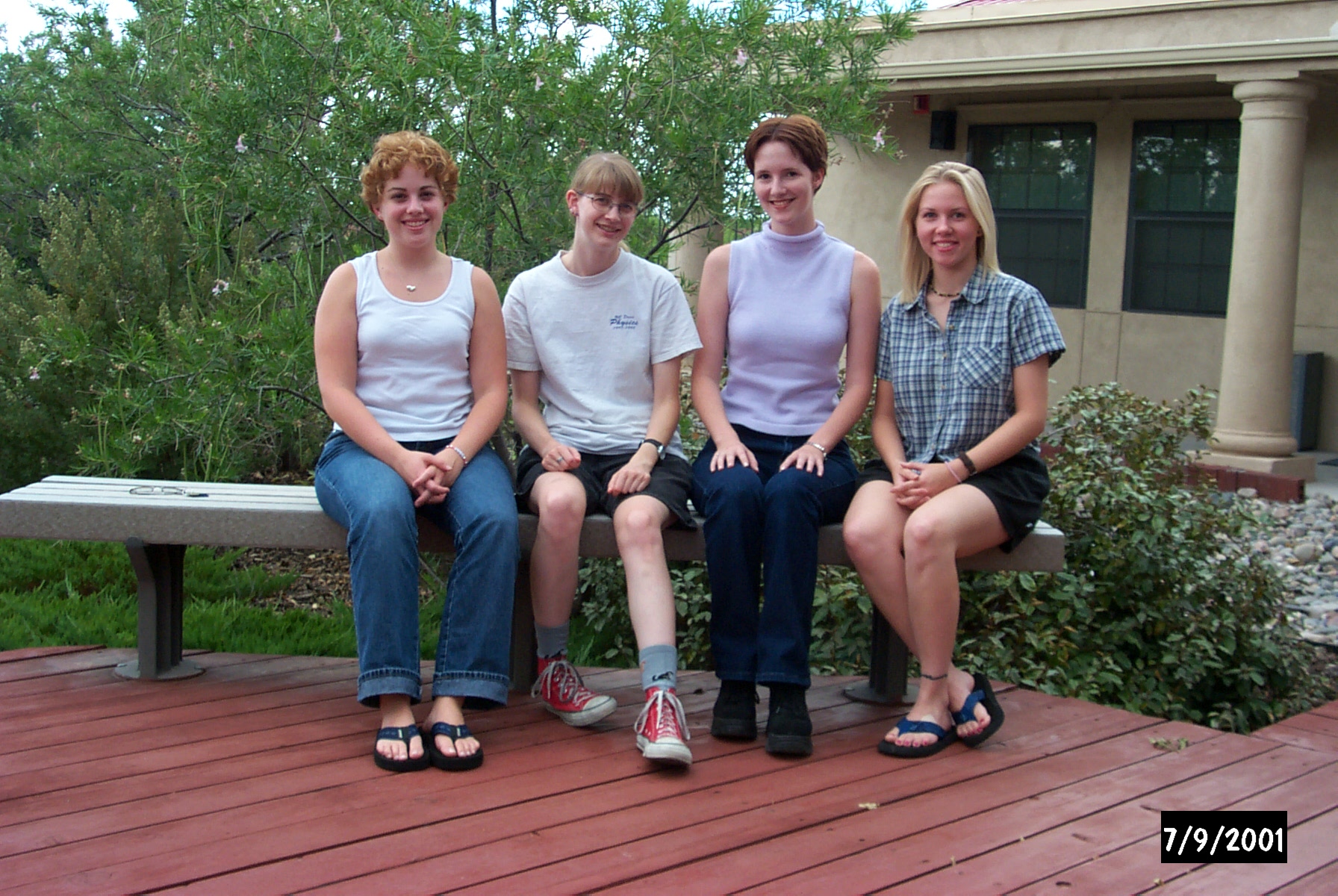
2001 Summer students Rebecca Rosengard, Daisy Raymondson, Sarah Flynn,
and Virginia Valentine
In addition to the general activities carried out at the KPNO/NOAO offices,
the NRAO and KPNO/NOAO REU students participate in group activities organized
by the NRAO staff.
One activity will be a lecture series on millimeter wavelength astronomy
given by members of the NRAO scientific staff. Four lectures were given,
as listed below. Students also visited the Array Operations Center and
Very Large Array in Socorro, NM.
2001 NRAO Tucson Summer Student Calendar of Events
June 2001
June 20-21 - Trip
to Kitt Peak with NRAO Socorro REUs
July 2001
July 9-10: Trip to VLA/NRAO Socorro.
July 12: 10:00 am. "Radio Astronomical Observations
of the Solar System and Star Formation" by Jeff Mangum
July 19: 10:00 am. "The Cosmic Microwave
Background" by Simon Radford
July 24: 10:00 am. "Radio Astronomical Observing
Techniques" by Darrel Emerson
August 2001
August 1: 10:00 am. "Interferometric Imaging" by
Mark Holdaway
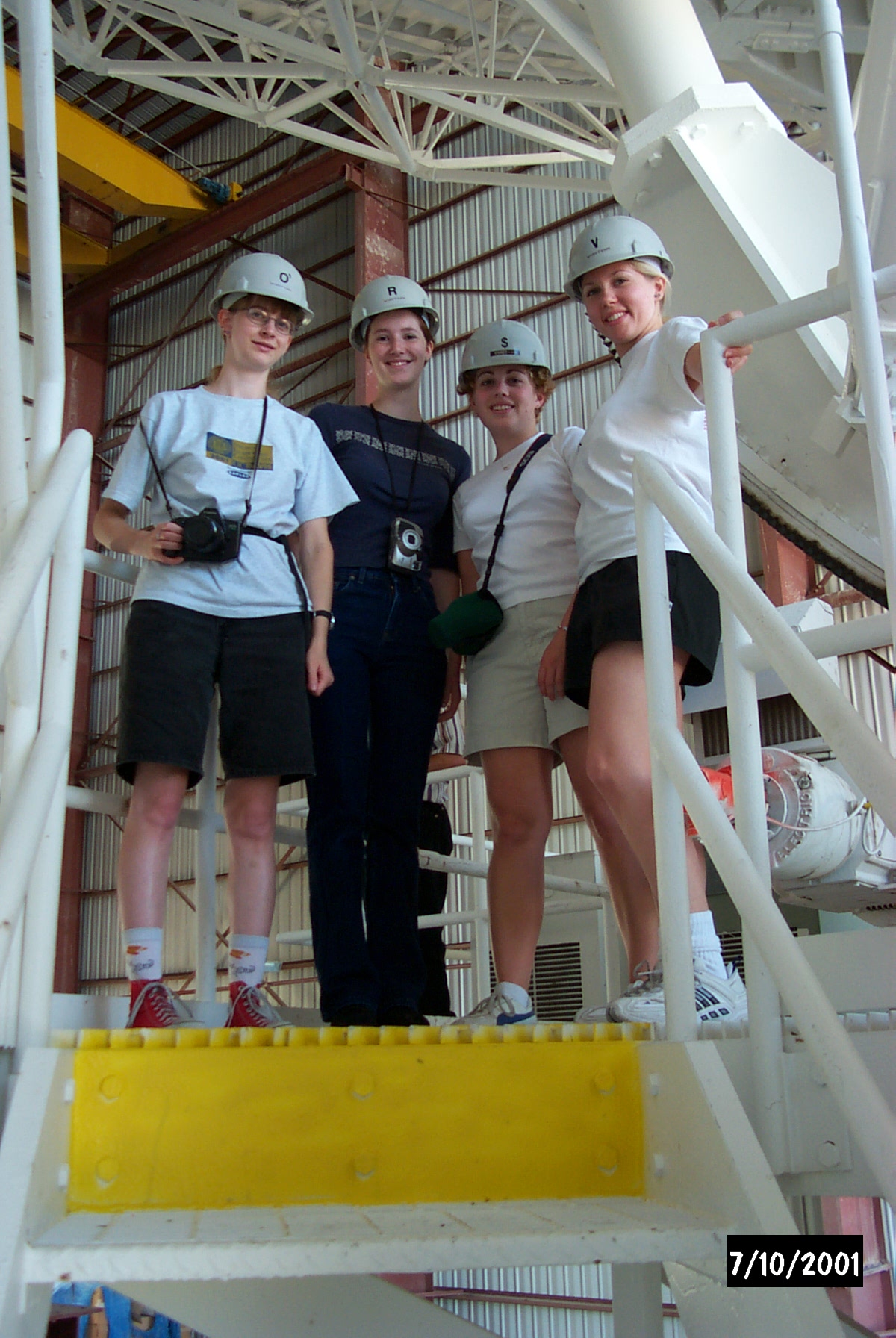
2001 Summer students get a tour of the VLA antenna from Jeff Mangum.
The following are sketches describing the work to be done by each REU
student at NRAO Tucson.

Sarah Flynn, of State
University of New York at Stony Brook 
works with Jeff Mangum
Molecular Outflow Properties
Ms. Flynn will work on the analysis of CO 2-1 measurements of the molecular
outflow properties toward protostellar and young stellar candidates in
the Ophiuchus and Taurus molecular cloud regions.

ALMA Amplitude Calibration System
A proposed calibration scheme for ALMA uses two radiators at different temperatures mounted behind the subreflector. Based on a design developed at UC Berkeley, a prototype calibration radiator was constructed and tested in the laboratory.
Results were summarized in an internal report.

The ALMA Nutator Control System
The ALMA subreflector nutator is a high performance, recoilless design. In the laboratory, the dynamic responses of the major components of an engineering demonstration model were characterized. These measurements were used to refine a mathematical model
of the mechanism. This model is the basis for tuning the servo system parameters.
Results were summarized in an internal report.

The ALMA Site
Since late 1997, tipping radiometers have measured the submillimeter (350 um) atmospheric transparency at Chajnantor, Mauna Kea, and the South Pole. Data from these instruments were edited and processed to produce a uniform database. Overall observing
conditions and diurnal and seasonal variations in conditions at the three sites were compared.
Results will appear in a journal paper.


Take me to the 2000
Summer student Home Page
Take me to the 1999
Summer student Home Page
Take me to the 1998
Summer student Home Page
Take me to the 1997
Summer student Home Page
Take me to the 1996
Summer student Home Page
Take me to the 1995
Summer student Home Page
Back to the Home
Page
Take me to the Shakespearean
Insult Server
 National Radio Astronomy Observatory
National Radio Astronomy Observatory
 National Radio Astronomy Observatory
National Radio Astronomy Observatory





































































